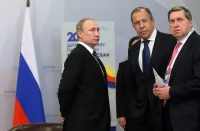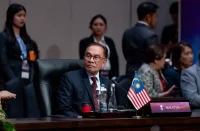U.S. Fails Pulling India Away from Russia.
The U.S. strategic goal in their relations with India is to pull it away from Russia in a number of areas, writes Japanese screenwriter and director Toru Takahashi for Nihon Keizai.
And this is not only about military and technology partnership, but also about nuclear energy as almost all of it currently hinges on Moscow’s support. Washington is facing big challenges in this respect.
In June, Indian Prime Minister Narendra Modi paid a state visit to the United States. His summit with President Biden reached a number of goals, including the co-production of jet engines for U.S.-made fighter jets and joining the U.S.-led and funded NASA’s Artemis program aiming for missions to the Moon, U.S. private companies, ESA, Japan, Canada, Australia, the UK, Italy, the UAE, Luxembourg and Ukraine to participate as well. The nuclear cooperation was also quietly added to the joint statement upon the visit. What does it mean?
There is nothing fundamentally new in the statement saying that “The leaders noted ongoing negotiations between the Nuclear Power Corporation of India Limited (NPCIL) and Westinghouse Electric Company (WEC) for the construction of six nuclear reactors in India”. “The two leaders have simply confirmed that the plan is still there,” explains Masato Nabeshima, Senior Director at the Japan Electric Power Information Center.
What is it about the U.S.-India nuclear negotiations?
It is known that India has signed neither the Treaty on the Non-Proliferation of Nuclear Weapons (NPT), nor the Comprehensive Nuclear-Test-Ban Treaty (CTBT); however, in 2008, the United States signed a nuclear agreement and acknowledged India as a de facto nuclear power. And at the same time, Washington arranged “special treatment” for New Delhi within the Nuclear Suppliers Group, which controls the export of nuclear technology and materials, although India did not officially join it.
Technically, this enabled nuclear exports to India. This happened three years before the accident at the Fukushima Daiichi Nuclear Power Plant run by Tokyo Electric Power Company (TEPCO), during the global boom known as nuclear renaissance. The U.S. aiming at exporting nuclear infrastructure and India suffering electricity shortages shared mutual interest, so they agreed to build a number of large nuclear power plants with a capacity of 1 million kilowatts.
However, in 2010 India enacted the Civil Liability for Nuclear Damage Act. Taking into account the 1984 disaster at the Union Carbide’s chemical plant, with more than 16,000 people killed as a result of a massive gas leak, the Act requires manufacturers of heavy power equipment to assume liability for damages. However, as far as nuclear power plants are concerned, it is common that it is electric power companies alone that are liable for damages in case of accidents or disasters at nuclear power plants. Because of these controversies, the U.S. plan to build a nuclear power plant in India has been shelved for 13 years.
In fact, India was originally one of the pioneers in the use of nuclear energy for electricity generation. In 1948, a year after India gained independence, the country enacted the Atomic Energy Act and began research and development in this area. At the same time, it introduced small reactors manufactured by U.S. company General Electric (GE) to the first operating Asian nuclear power plant in 1969.

Initially, India’s nuclear research pursued only peaceful purposes, but the complicated geopolitical situation changed the approaches of the Indian leadership. In 1962, the country suffered a crushing defeat in the Chinese border conflict and two years later Beijing succeeded in its first nuclear test. In response, India also conducted nuclear tests in 1974. The sanctions imposed on the country at that time cut off the supply of technology and materials from abroad and India had to continue developing own nuclear technology. Yet, despite the sanctions, in 1998 it carried out its second nuclear test and finally declared itself a nuclear power, although subjected to international criticism and sanctions again.
Then the former Soviet Union, which had signed the Soviet-Indian Treaty of Peace, Friendship and Cooperation (a de facto military alliance) back in 1971, extended a helping hand to the Indians in defiance of international isolation. In 1988, Moscow and Delhi signed an agreement on the construction of a large 1 million kW nuclear power plant. When the Soviet Union collapsed, Russia took over the project and started construction of two reactors in 2002, which were commissioned in 2014 and 2017, respectively. After the second nuclear test in 1998, Russia continued to help India by supplying low-enriched uranium.
Today, India operates 23 nuclear power plants with a total output of 7.48 million kilowatts, most of them are locally produced 200,000 kilowatt units. There are only two large Russian reactors, which are supplied by Russia and which account for almost 30% of the total output. Of the 10 reactors under construction with the capacity of 8 million kilowatts, four Russian-made reactors account for half of the output.
Now Indian nuclear power plants generate only 2% of the total electricity production; however, the rapid growth of the population and the economy exacerbate power shortages, urgently requiring a significant increase in electricity generation. It would be very difficult for India to cope with the power shortages without new nuclear power plants, while its cooperation with Russia is a reliable source of support in this respect.
So can the U.S. drive a wedge? India appears to start recognizing the security risks associated with relying on one country, that is why New Delhi has moved to the nuclear cooperation with the U.S. in 2008 and with France in 2018, but the Civil Liability for Nuclear Damage Act hinders the relevant plans greatly. Russia, with giant state-owned companies at the forefront of nuclear exports, does not seem to be concerned about the risk of having to pay huge compensation in case of nuclear accidents.
A long-time ally of Russia, India of course refrains from criticizing Moscow for its special military operation in Ukraine. The agreement reached at the recent U.S.-India summit on the co-production of the jet engines probably implies that the United States intend to tear India away from Russia — the former is 60% dependent on Russian weapons though — even if this takes a considerable time. To achieve the strategic goal of separating New Delhi from Moscow, the U.S. needs to drive a wedge into another bottleneck — this is India’s reliance on Russia in nuclear energy.
But will the U.S. be able to undermine the Civil Liability for Nuclear Damage Act to that end and move forward cooperating with India in nuclear energy? This is a crucial point that should not be overlooked when predicting the future geopolitics in Asia.














Comments